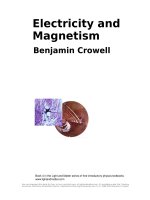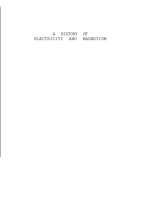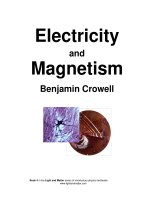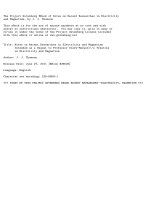Electricity and magnetism 1
Bạn đang xem bản rút gọn của tài liệu. Xem và tải ngay bản đầy đủ của tài liệu tại đây (7.6 MB, 27 trang )
Electricity
and
Magnetism
Lessons 1– 3
Copyright © by Harcourt, Inc.
All rights reserved. No part of this publication may be reproduced or transmitted in
any form or by any means, electronic or mechanical, including photocopy, recording,
or any information storage and retrieval system, without permission in writing from the
publisher.
Requests for permission to make copies of any part of the work should be addressed to
School Permissions and Copyrights, Harcourt, Inc., 6277 Sea Harbor Drive, Orlando,
Florida 32887-6777. Fax: 407-345-2418.
HARCOURT and the Harcourt Logo are trademarks of Harcourt, Inc., registered in the
United States of America and/or other jurisdictions.
Printed in the United States of America
ISBN-13: 978-0-15-349173-3
ISBN-10: 0-15-349173-6
1 2 3 4 5 6 7 8 9 10
179
15 14 13 12 11 10 09 08 07 06
If you have received these materials as examination copies free of charge, Harcourt
School Publishers retains title to the materials and they may not be resold. Resale of
examination copies is strictly prohibited and is illegal.
Possession of this publication in print format does not entitle users to convert this
publication, or any portion of it, into electronic format.
Electricity
and
Magnetism
Lessons 1–3
Lesson 1
What Is Static Electricity? . . . . . . . . . . . . . . . . . . . .2
Lesson 2
What Makes a Circuit? . . . . . . . . . . . . . . . . . . . . .10
Lesson 3
What Are Magnetic Poles? . . . . . . . . . . . . . . . . . .18
Visit The Learning Site!
www.harcourtschool.com
1
VOCABULARY
VOCABULARY
electric charge
static electricity
electric field
What Is
Static
Electricity?
A plus sign or a minus
sign stands for an electric
charge. Matter can have
either a positive (plus sign)
or a negative (minus sign)
electric charge. Some
matter does not have either
charge.
2
--
This girl has a buildup of
electric charges in one
place. This is why the socks
stick to her sweater. Such
a buildup is called static
electricity.
+
The area around an electric
charge is called the electric
field. It is where electric
forces act.
3
READING FOCUS SKILL
CAUSE AND EFFECT
A cause is something that makes another thing
happen. An effect is the thing that happens.
Look for things that cause electric charges to build
up. Look for the effect this has on objects.
Two Kinds of Charge
You already know the word electricity. Electricity is a
kind of energy. This energy depends on properties of
matter. Many of the tiny particles that make up matter
have an electric charge. These charges can be positive or
negative.
Positive and negative charges can cancel each other
out. Matter is usually neutral, not positive or negative.
The charges are usually in balance.
Rubbing the balloon
causes a charge.
4
Positive charge
Negative charge
Positively charged objects and negatively charged
objects affect each other. Opposite charges attract, or pull
toward each other. Charges that are the same repel, or
push away from each other
The buildup of charges in one place is called static
electricity. When clothes rub against each other in the
dryer, they cause static electricity.
What causes static electricity?
Objects that have the
same charge push away
from each other. Objects
with different charges pull
toward each other.
5
Separating Charges
Most of the time, you, a balloon, and a doorknob
are neutral. This means that the numbers of positive
and negative charges are equal. When the numbers are
not equal, you can see electric forces act. To make the
numbers not equal, you must separate negative charges
from positive charges.
Rubbing can pull negative particles from one object and
put them onto the other. Rubbing does not cause positive
charges to move.
As clothes tumble in the dryer, different
fabrics rub against one another. Negative
charges move from one piece of clothing
to another. When this happens, the
clothes stick together.
6
What causes a negatively charged balloon to stick to a
neutral wall? This happens because there is another way
to separate charges. The balloon’s negative charges repel
negative charges in the wall. The wall’s negative charges
move away a little. They are now separated from the
wall’s positive charges. The balloon’s negative charges are
then attracted to the wall’s positive charges. The balloon
sticks to the wall.
What are two ways you can cause charges to
separate?
D The balloon
is neutral.
It has the
same number
of positive
and negative
charges.
The balloon is
negatively charged.
The negative charges
on the wall are pushed
away. The balloon is
attracted to the wall’s
positive charges. It
sticks to the wall. C
7
CXECA08ARD4011-3_BLR.indd 7
9/29/06 11:59:26 AM
Electric Forces
Positive and negative electric charges have electric fields
around them. An electric field is the space in which an
electric force acts. An electric field extends in all directions
from the charge. A positive charge’s field attracts any
nearby negative charge. It repels any nearby positive
charge.
An electric field
One balloon has a positive charge. The other has
a negative charge. The pattern of lines shows the
electric field between them.
8
The diagram on this page shows what the electric fields
around two negatively charged balloons look like. The
lines show that the balloons repel each other.
What causes an electric force?
Electric field around
two negatively
charged balloons
Review
Complete the following cause and effect
statements.
1. An ______ ______ is a property of some
matter.
2. Charges can be ______ or ______.
3. The buildup of charges in one place is called
______ ______ .
4. An ______ ______ is the space in which an
electric force acts.
9
�
VOCABULARY
VOCABULARY
electric current
electric circuit
series circuit
parallel circuit
resistance
short circuit
What
Makes a
Circuit?
An electric current brings
electric energy to light the
bulb.
10
The bulb lights because it
has a steady flow of electric
current. The continuous
pathway is called an electric
circuit.
Both bulbs light because
there is one path that allows
current to flow. This is called
a series circuit.
A parallel circuit has two or
more paths where current
can flow. If one bulb goes
out, the others stay on.
The filament in this light
bulb has a high resistance.
This means it reduces the
flow of electric current.
In this picture, electricity is
flowing where it should not.
That creates a short circuit.
11
CXECA08ARD4011-3_BLR.indd 11
9/29/06 11:59:27 AM
READING FOCUS SKILL
CAUSE AND EFFECT
A cause is something that makes another thing
happen. An effect is the thing that happens.
Look for what causes an electric circuit.
Look for the effect a type of circuit has on
electricity.
Moving Charges
One form of electricity is current electricity. When
electric charges have a path to follow, they move, or flow.
The flow of electric charges is called electric current.
Current electricity is a steady flow of charges.
An electric circuit is a closed path through which
electric current flows. A battery is an important part of
a circuit. It provides energy. The energy moves electric
charges through the circuit.
A Trace the path of the current
through each part of the circuit.
12
Current flows through the circuit below. It flows like
water through the trays of the fountain. You control a
fountain by closing off a pipe. You control the path of
current electricity by opening a switch. This breaks the
path of the current flow.
What causes electric charges to flow?
If you break the path,
you can stop the
current. This turns off
the electricity.
13
Series Circuits
A series circuit has only one path for current to follow.
It’s like riding on a Ferris wheel. You have to go all the
way around to get back to the start.
A series circuit can have more than one bulb. The
electric current moves from the battery through the
wire. It passes through each bulb. Then it returns to the
battery.
This is a diagram of a series circuit.
More than one bulb can be lit up in
this type of circuit.
battery
wire
bulbs
14
In a series circuit, taking out any part stops the flow
of electricity. The bulb will not light. Current flows only
when everything is connected.
A series circuit works well in a simple device such as
a flashlight. You would not use a series circuit for your
whole home. To make one light work, you’d have to turn
them all on!
How does a series circuit turn off?
This is a series circuit.
If you took out one
light bulb, all the lights
would go out.
15
Parrallel Circuits
A better way to wire your home is to use parallel
circuits. A parallel circuit has more than one path for
the current to follow. If something blocks one path, the
charges can flow along another path. At least one light
stays lit.
In a parallel circuit, the current splits among different
paths. People can turn devices on or off at different times.
Plugging in more devices does not change how the circuit
works.
You have three devices turned on along a
parallel circuit. If you remove one device,
what happens to the others?
A This is a parallel circuit. There is more than one path for
the current to flow along. You can block one path, or
remove a bulb. The other bulbs will still light.
16
Resistance
The flow of electricity is like car traffic. If there are many
lanes, cars can move easily. If cars must share one lane,
traffic slows down. The amount of current that can flow
through a circuit depends on resistance. Resistance is
how much a material slows down the flow.
Sometimes a wrong connection is made. The current
takes a short cut. The short cut is called a short circuit. In
a short circuit, current flows where it isn’t wanted. Short
circuits prevent the rest of a circuit from working properly.
What can cause the flow of electricity to
slow down?
Review
Fill in the cause and effect statements.
1. A battery moves energy through an ______
______ .
2. If one light is disconnected in a ______
circuit, they all go out.
3. A ______ circuit allows current to flow along
more than one path.
4. ______ slows down the flow of current.
17
�
VOCABULARY
VOCABULARY
magnet
magnetic poles
magnetic field
What Are
Magnetic
Poles?
A magnet attracts iron and
some other metals. This
large magnet attracts a
paper clip through three
sheets of paper.
18
The metal filings are
affected by the magnet.
They show where magnetic
field is located.
Every magnet has two
magnetic poles. The N and
S ends of the magnet are
where it can pull with the
largest force.
19
READING FOCUS SKILL
MAIN IDEA AND DETAILS
The main idea is what the text is mostly about.
Details are pieces of information about the main idea.
Look for details about magnetic fields and magnetic
poles.
Two Poles
A magnet is an object that attracts certain materials.
These materials usually contain iron. The two ends of a
magnet are called magnetic poles. The magnetic force is
strongest near the two poles.
When you hang a bar magnet and let it turn, one end
points north. This end is called the north-seeking pole (N).
The other end is the south-seeking pole (S).
A magnet
always has a
north-seeking
pole, labeled
N. It also has a
south-seeking
pole, labeled
S. If you cut a
magnet, each
piece still has N
and S poles.
20
Magnetic poles act like electric charges. Opposite poles
attract. Same poles repel. Opposite poles placed near
each other will pull toward each other. When same poles
are placed near each other, they push apart.
How are all magnets alike?
The iron filings show the two
N poles repelling. Same poles
repel each other.
The iron filings show the N
and S poles attracting. Unlike
poles attract each other.
21
Magnetic Forces
A magnetic field is the area in which the magnetic force
of a magnet acts. In the picture, a bar magnet moves
iron filings into the shape. The shape shows the magnet’s
magnetic field. Lines form between the North and South
poles of the magnet. These lines are called magnetic field
lines. They show lines of magnetic force.
Magnetic force gets stronger as the magnetic object
gets closer. The force of the magnet is strongest at the
poles. The iron filings are attrated to the magnet mostly
near the poles.
Where on the bar magnet is the force the
strongest?
magnetic field
22
Magnet Shapes
Magnets come in many shapes and sizes. They are
made for different uses. Some are shaped like horseshoes.
If you straightened the horseshoe out, the poles would
be at the ends. You might have a flat rubber magnet at
home. These magnets are made up of stripes of magnetic
material. The material bends.
Why do magnets have different shapes?
�
�
�
�
�
�
�
�
�
�
�
�
�
Notice that the N and
S are directly opposite
each other.
�
Review
�
�
Complete this main idea statement.
1. A ______ ______ is the place on a magnet
where the force is the strongest.
Fill in the detail statements about magnets.
2. A ______ is an object that attracts iron and
some other metals.
3. The space in which the magnetic force acts
around a magnet is called the ______ ______ .
4. Even if a magnet has different shapes, it will
always have a ______ and a ______ pole.
23








